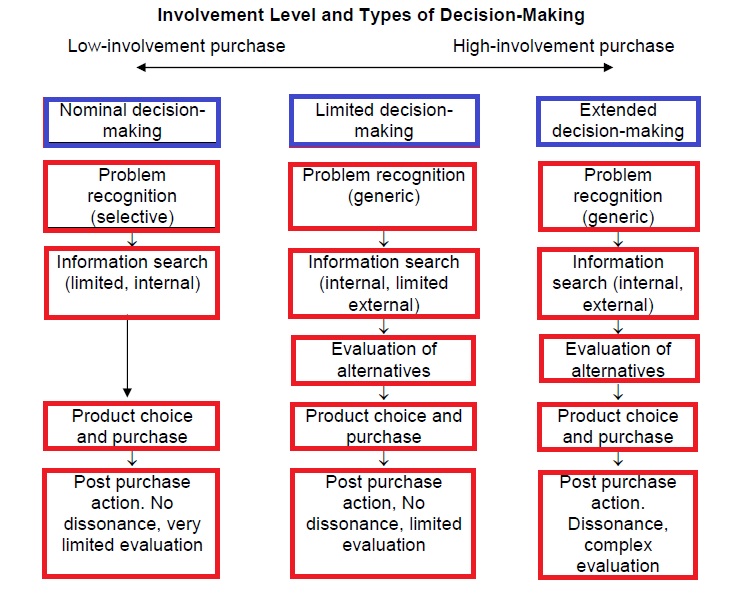Consumer involvement is considered as an important variable that can help explain how consumers process the information and how this information might influence their purchase or consumption related behavior. However, there is wide agreement that the degree of involvement has a very significant effect on consumer behavior.
Herbert Krugman, a researcher is credited with his contribution to the concept of consumer involvement. According to him, consumers approach the marketplace and the corresponding product/service offerings with varying levels and intensity of interest and personal importance. This is referred to as consumer involvement.
Involvement variables are believed to precede involvement and influence its nature and extent. These variables are believed to be the sources that interact with each other to precipitate the level of consumers involvement at any particular time and situation. The extent of risk perception the consumer has with purchase decision can also influence the level of involvement. The perceived risk is the outcome of consumer’s perception of the chances of potential degree of resulting unfavorable consequences from making a purchase decision, such as financial loss, or physical or psychological harm. Researchers have suggested that the level of involvement may also be influenced by promotional messages and the media used.
Purchase involvement is the level of concern for, or interest in, the purchase process stimulated by the need to consider a certain purchase. It is important to realize that consumer involvement can take many forms and a broad distinction is that it can be cognitive, such as a consumer may be motivated to learn about the latest specifications of the new iMac; or emotional, when a consumer is considering the purchase of a gift for his wife on their first marriage anniversary. There are several broad types of involvement related to the product, the message, or the perceiver.
- Product involvement refers to a consumer’s level of interest in a certain product. Marketers communicate many sales promotions to increase consumer involvement in a product. Tata Indica V2 sponsored a contest in which participants were to submit five words that describe the car starting with the letter “V.”
- Advertising involvement refers to the consumer’s interest in processing the ad messages. Television is said to be low-involvement medium and consumers process information in a passive manner. In contrast, print is a high-involvement medium as the readers actively process information.
- Purchase situation involvement may occur while buying the same item in different contexts. For example, when a consumer wants to impress someone, she/he may buy a different brand that reflects elegance and taste in a better way than the usual one that she/he buys.
There are various types of consumer-decision processes. It is useful to view purchase decision involvement as a continuum and as the consumer moves from a low level of involvement with the purchase situation to a high level of involvement, purchase decision-making becomes increasingly complex. Based on the amount of effort that goes into decision-making, consumer researchers have found it convenient to think that on one end is the habitual purchase decision-making or nominal decision-making and at the other extreme is extended decision-making. Many decisions fall somewhere in the middle and are characterized by limited decision-making. It should be kept in mind that the types of decision processes are not distinct but rather blend into each other.
Nominal decision-making is also referred to as nominal problem solving, habitual decision-making, or routine problem solving. Recognition of need is likely to lead directly to an intention to buy. Information processing is very limited or non-existent. There is generally low-involvement with most low priced and frequently purchased products, which are consumed on an ongoing basis and involve nominal decision-making. A problem is recognised, consumer’s internal search from long-term memory comes up with a single preferred solution, the preferred brand is purchased and no brand evaluation occurs unless the brand fails to perform as expected. Some of these decisions are so nominal that the consumer does not even think of purchasing an alternative brand. Nominal decision-making is generally the outcome of continued satisfaction with a brand which was initially chosen after an extended decision-making process, or the consumer does not attach much importance to the product category or purchase. The consumer buys Sensodyne toothpaste without further consideration because it meets her/his overall needs, even though using the best available toothpaste is important to her/him. In the second situation, consumers may not attach much importance to salt or sugar they buy for household consumption. Having tried Tata Salt and found it satisfactory, they now purchase it repeatedly without any thought, when it is needed. In this category, sales promotions can lead to considerable brand switching.
Limited decision-making is usually more straightforward and simple. It involves internal (long-term memory) and limited external search, consideration of just few alternatives, simple decision rules on a few attributes and little post purchase evaluation. As pointed out earlier, it covers the middle ground between nominal and extended decision-making. Buyers are not as motivated to search for information, or evaluate each attribute enthusiastically, but actually use cognitive shortcuts. When the level of consumer involvement is lowest, limited decision-making may not be much different than nominal decision-making.
Extended decision-making corresponds most closely to the traditional decision-making perspective. Such decisions involve extensive internal (long-term memory) and external (outside sources) information search followed by a rigorous evaluation of several alternatives because consumers do not possess any meaningful information about the product or service and need lots of it. The evaluation often involves careful consideration of attributes of one brand at a time, and taking stock of how the attributes of each brand measure up to a set of desired characteristics. All this happens in response to a high level of consumer’s involvement in making a purchase decision. Such complex decisions are relatively few and may relate to buying a computer, stereo system, washing machine, laser printer, or a new house. Post purchase evaluation is more likely to be complex and dissonance causing.
